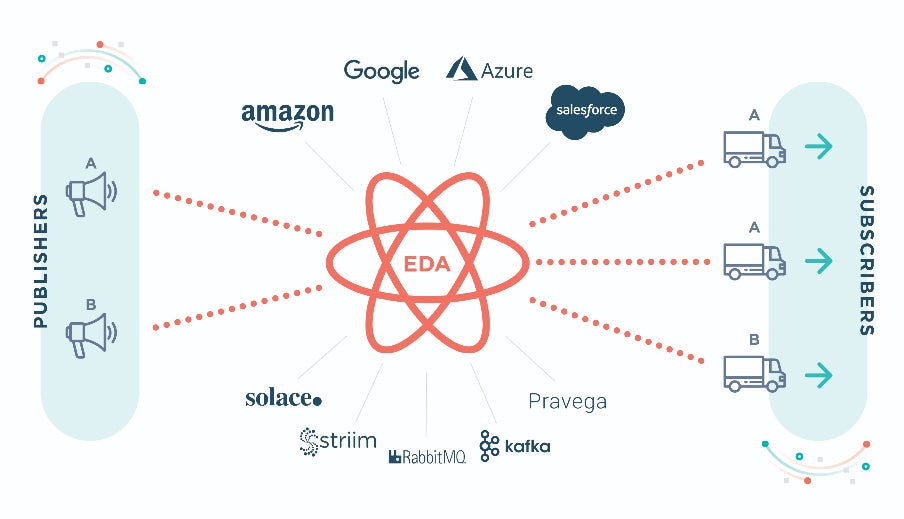Event-driven systems — and the architectures to support them — are integral to digital transformation efforts as organizations drive towards a more robust omnichannel experience.
With the increasing demand for disparate systems of record to interact in real-time across digital and legacy platforms, event-driven architectures (EDAs) have found their niche in this digital age. Boomi’s new EDA initiative — EDA powered by Boomi — will address a growing number of technologies in this space that includes queuing but also encompasses messaging brokers, event meshes, real-time streaming, analytics and asynchronous APIs. It will offer an ecosystem of options that customers can use to ease the challenges inherent in event-driven system implementations.
EDA Powered by Boomi Adds Rich Features To the Boomi Platform
Boomi has partnered with industry-leading EDA providers to bring new solutions to our platform. EDA Powered by Boomi will offer event-driven technologies through connectors that our users can access via our simple, drag-and-drop development environment.
Customers can continue to experience Boomi’s legendary ease of use while deploying integrations across all their systems and gain the advantages of event-driven integrations.
Boomi’s EDA options add another layer of flexibility to our scalable platform. You’ll be able to choose the technology and protocol that best suits your needs.
As EDA technologies mature, we’ll continue to build out the capabilities of our platform to further support this powerful integration technology. Here are some of the EDA connectors you can use today, and more are coming soon!

As we release new connectors this fall, you’ll notice some changes to our user interface (UI) as shown below.We’ve built a roadmap around you — our customer. Please let us know any technologies we should incorporate for your use case by submitting a Product Feature Request to our ideas page.
We’d love your feedback on new features! Visit our ideas page to let us know what you like, and what you’d like to see.
Figure 2. User Interface changes will showcase EDA solutions

EDAs Extend the Capabilities of Service-Oriented Architectures
The client-driven nature of service-oriented architectures (SOAs) can limit the scalability of certain systems. EDAs do not replace but rather complement SOAs. While SOA is generally a better fit for a request/response exchange, EDAs provide long-running asynchronous process capability. This is why EDA can be referred to as “event-driven SOA.”
For our customers, the attraction of EDAs stem from a desire to exploit vast amounts of cheap compute and storage resources. With the advent of the cloud and the drive towards big data solutions, which allows data harvesting and analysis at terabyte, petabyte and exabyte scales, customers need solutions that can eliminate the known bottlenecks and deficiencies of traditional SOAs.
Multiple EDA technologies exist today, such as Kafka, SQS, Solace and RabbitMQ. Each underlying protocol ensures a strict adherence to the agreed upon standard across an industry, market segment or organization. They define the data, security model, integration path and control flow.
With EDAs, organizations can:
- Extract information from one data silo and expose it to multiple sources. Ex: EDI or supply chain management
- Create a centralized event bus for enterprise applications and microservices to send and receive events
- Balance workloads in network clusters and gain high availability. Ex: tasks not yet processed can be set in a queue with specific priorities (QOS)
- Implement asynchronous workflows. Ex: Multiple events can initiate activities across different systems, all at once, without impacting the origination point
- Distribute event notifications. Ex: A payment event triggers several actions such as sending a confirmation email to the customer, notifying billing to complete transaction, and an order manifest to be sent to a 3rd party shipment agency.
- Stream data from various processes or devices. Ex: A sensitive piece of data is extracted from a health care system and is pushed to multiple parties for analysis, scheduling and confirmation.
Event Thinking and the Growing Importance of Event-Driven Architectures
Right up there with artificial intelligence (AI), actionable analytics, Smart Industry 4.0, blockchain and other tech fashionista buzzwords is “Event Thinking.” What is that exactly?
Gartner calls event thinking “real-time situational awareness,” meaning that systems immediately detect and respond when certain conditions are met. Any set of conditions can count as an “event.”
Event thinking isn’t really new, but it’s moved from the backroom to the C-suite as organizations bring more digital solutions online that employ event-driven systems — solutions that directly affect manufacturing, operations, customers, customer service and, by extension, cost and revenue.
Event-based thinking is what makes the practical application of EDAs possible and is a necessary step for gaining the full value proposition of EDAs, since all events should be considered holistically. With EDA powered by Boomi, your organization can make event thinking part of your digital transformation strategy.
To learn more about how Boomi helps power event-driven systems, visit our EDA page.


 English
English 日本語
日本語